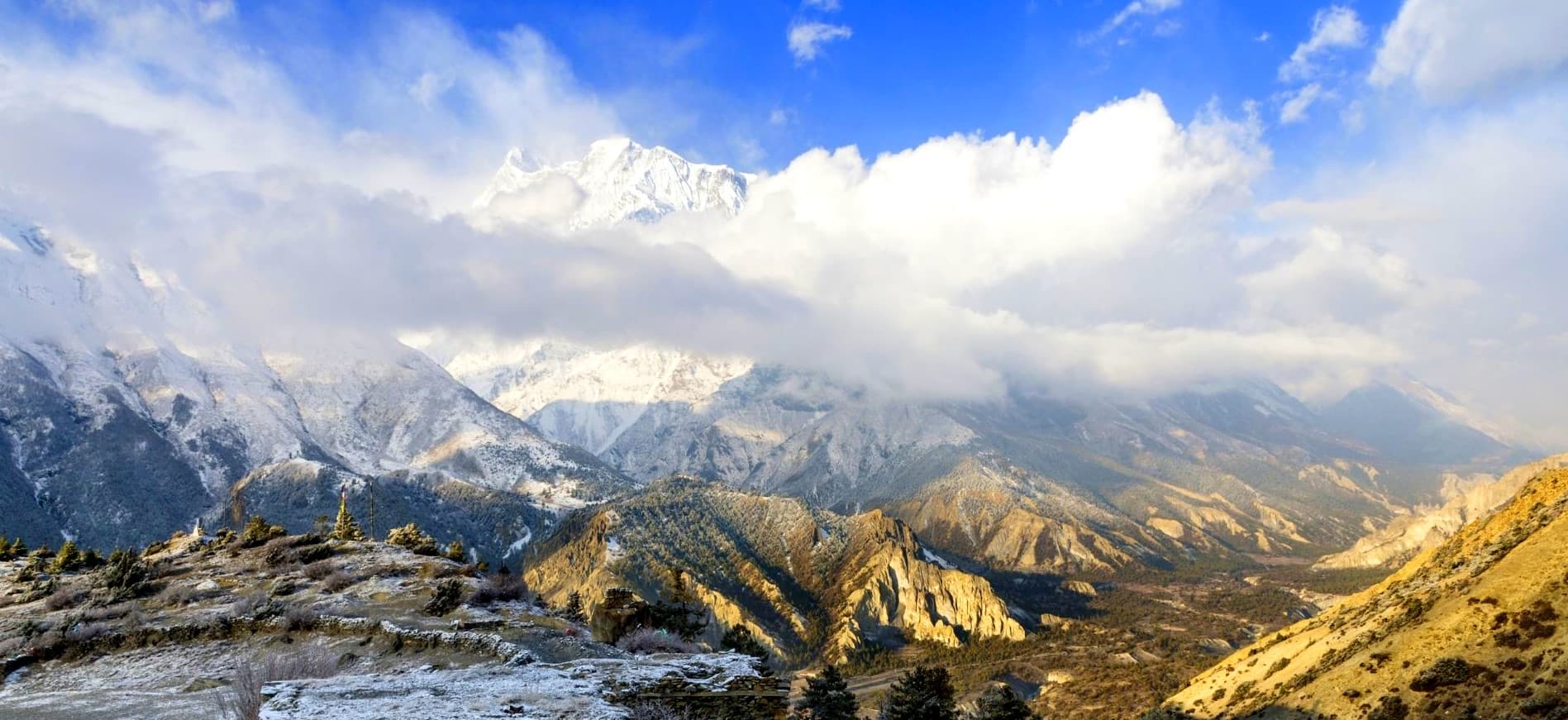The Annapurna region in Nepal beckons trekkers with two distinct and captivating routes: the Annapurna Base Camp Trek and the Annapurna Circuit. These renowned trekking experiences offer unparalleled glimpses of the Himalayas while presenting varying challenges and landscapes. The Annapurna Base Camp Trek, spanning 7 to 11 days, unveils the majestic Annapurna and Machapuchare peaks amidst verdant forests and traditional villages, catering to those seeking a moderate yet awe-inspiring journey.
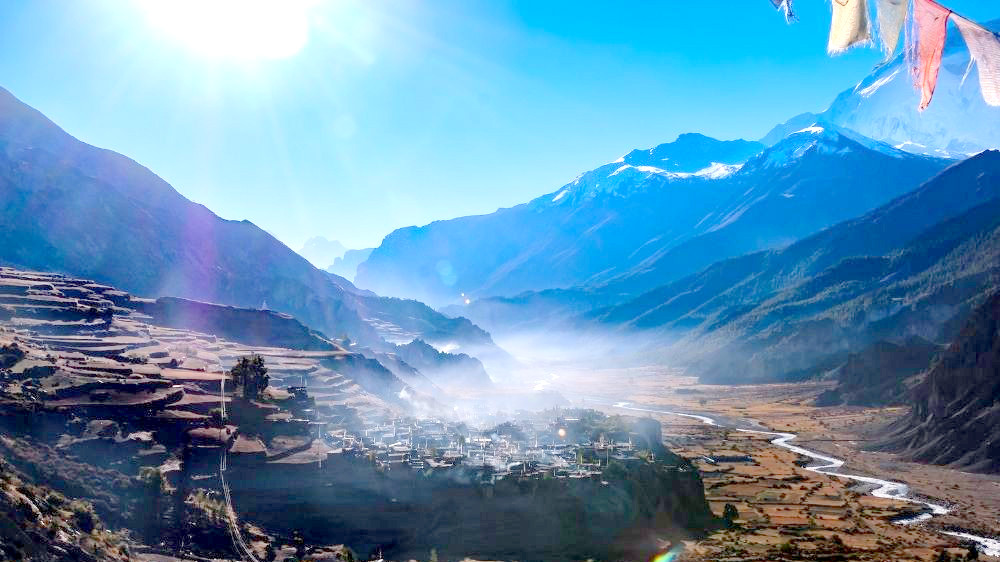
On the other hand, the Annapurna Circuit, a longer expedition spanning 15 to 20 days, encircles the Annapurna Massif, treating adventurers to diverse terrains, from subtropical woodlands to the high-altitude Thorong La Pass at 5,416 meters, and granting profound cultural encounters with local communities. Choosing between these treks hinges on the desired duration, difficulty, and the balance between natural beauty and cultural immersion.
What is the duration of each trek?
The duration of each trek can vary based on factors such as your trekking pace, acclimatization days, and specific route variations. However, I can provide you with general estimates for the duration of both the Annapurna Base Camp Trek and the Annapurna Circuit:
Annapurna Base Camp Trek
The Annapurna Base Camp (ABC) Trek is a relatively shorter trek compared to the Annapurna Circuit. The trek usually begins from Nayapul or Siwai, and the trail winds through beautiful forests, terraced fields, and traditional villages. The duration of the trek can vary depending on factors such as your starting point, trekking pace, and the number of acclimatization days you include.
Trek Duration: On average, the trek itself takes around 9 to 15 days to complete. This includes the trek from the starting point to Annapurna Base Camp and back down.
Typical Itinerary: A common itinerary might involve
Day 01: Arrival at Tribhuvan International Airport, Kathmandu, and Pre-trip meeting.
Day 02: Drive to Ghandruk via Pokhara from Kathmandu: 260 km/ 7-8 hours’ drive
Day 03: Trek from Ghandruk to Chhomrong: 4-5 hours trek
Day 04: Trek from Chhomrong to Dovan: 4-5 hours trek
Day 05: Trek from Doban to Deurali: 4-5 hours trek
Day 06: Trek from Deurali to Annapurna Base Camp and to Machhapuchhre Base Camp: 4-5 hours trek
Day 07: Trek from Machhapuchhre Base Camp to Sinuwa: 5-6 hours trek
Day 08: Trek from Sinuwa to Nayapul and drive back to Pokhara: 4-5 hours trek/1 hour drive
Day 09: Drive to Kathmandu from Pokhara: 200 km/ 5-6 hours drive
Day 10: Departure day: Transfer to the Tribhuvan International Airport for your departure.
Acclimatization: Some itineraries include additional acclimatization days to help you adjust to the altitude. These extra days might be spent at places like Chhomrong or Bamboo to minimize the risk of altitude sickness.

Annapurna Circuit
The Annapurna Circuit is a longer and more comprehensive trek that circumnavigates the entire Annapurna Massif. The trek covers a diverse range of landscapes and requires more time due to its greater length and higher altitudes.
Trek Duration: The Annapurna Circuit typically takes about 15 to 20 days to complete, considering the entire loop. The duration can vary depending on the specific route you take, side trips, and acclimatization days.
Typical Itinerary: An example itinerary might include:
Day 01: Arrival in Kathmandu
Day 02: Kathmandu cultural tour and trek preparation day
Day 03: Kathmandu to Bhulbhule
Day 04: Bhulbhule to Jagat
Day 05: Jagat to Dharapani
Day 06: Dharapani to Chame
Day 07: Chame to Pisang
Day 08: Acclimatization day in Pisang
Day 09: Pisang to Manang
Day 10: Acclimatization Day in Manang
Day 11: Manang to Yak Kharka
Day 12: Yak Kharka to Thorong Phedi
Day 13: Thorong Phedi to Muktinath via Thorong La Pass
Day 14: Muktinath to Jomsom
Day 15: Jomsom to Pokhara
Day 16: Pokhara to Kathmandu
Day 17: Departure from Kathmandu
Acclimatization: The Annapurna Circuit includes the challenging Thorong La Pass at an altitude of 5,416 meters, so acclimatization stops are crucial for adapting to the altitude and minimizing the risk of altitude sickness.
Keep in mind that these are approximate durations, and the actual time you spend on the trek can vary based on your preferences and circumstances. It's also important to factor in some additional days for potential rest, acclimatization, and flexibility in case of unexpected events.
What is the maximum altitude reached on each trek?
The maximum altitude reached on each trek is as follows:
Annapurna Base Camp Trek
The highest point of the Annapurna Base Camp Trek is Annapurna Base Camp itself, which is situated at an elevation of approximately 4,130 meters (13,550 feet) above sea level. This is the destination where trekkers are rewarded with spectacular views of the surrounding peaks, including Annapurna I, Annapurna South, Machapuchare (Fishtail), and others.
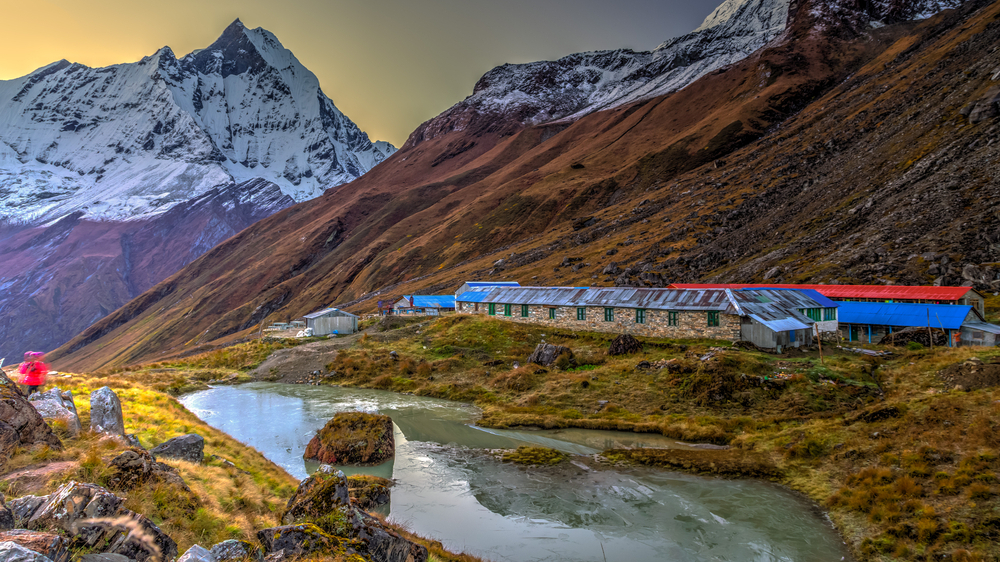
Annapurna Circuit
The Annapurna Circuit involves crossing the Thorong La Pass, which is the highest point of the trek. The Thorong La Pass is situated at an elevation of 5,416 meters (17,769 feet) above sea level. This pass is a significant highlight of the Annapurna Circuit, offering panoramic views of the Himalayas and the surrounding landscapes.
Challenges and Risks of Annapurna Base Camp vs Annapurna Circuit
Both the Annapurna Base Camp (ABC) Trek and the Annapurna Circuit come with their own set of challenges and risks, which trekkers need to be aware of and prepared for. Here's an overview of some potential challenges and risks associated with each trek:
Challenges and Risks of Annapurna Base Camp Trek
- Altitude Sickness: Altitude sickness, also known as acute mountain sickness (AMS), can affect trekkers as they ascend to higher altitudes, even on the Annapurna Base Camp (ABC) Trek. Symptoms include headaches, nausea, dizziness, and fatigue. To mitigate this risk, trekkers should acclimatize properly by ascending gradually, staying hydrated, and avoiding rapid altitude gains.
- Weather Variability: The weather in the Annapurna region can be unpredictable, especially as you climb higher. It's important to be prepared for sudden weather changes, such as rain, snow, or temperature drops. Carrying appropriate clothing layers and rain gear is essential.
- Limited Medical Facilities: As you get closer to Annapurna Base Camp, medical facilities become scarcer. Basic medical supplies might be available in some lodges, but serious medical emergencies require evacuation. Trekkers should carry a basic first aid kit with essentials like bandages, antiseptics, and medications.
- Avalanche Risk: The ABC Trek passes through areas where avalanche risk exists, especially during the spring when melting snow increases the likelihood of avalanches. Trekkers should stay informed about trail conditions and receive guidance from local authorities or guides regarding safe passage.
Challenges and Risks of Annapurna Circuit
- High-Altitude Pass Crossing: The most significant challenge of the Annapurna Circuit is the Thorong La Pass crossing. At an elevation of 5,416 meters (17,769 feet), this pass requires proper acclimatization, as rapid ascents can lead to altitude sickness. Trekkers should spend time at higher altitudes to adapt before attempting the pass.
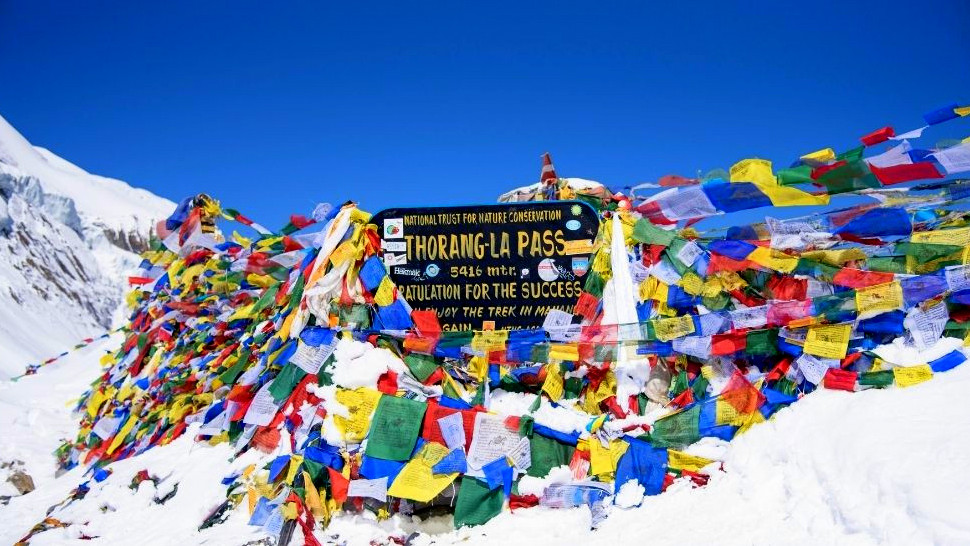
- Altitude Sickness: The circuit involves substantial altitude gain, which increases the risk of altitude-related issues. Trekkers should recognize the symptoms of AMS and take preventive measures such as gradual ascent, staying hydrated, and avoiding alcohol.
- Weather Extremes: The weather at higher altitudes, especially around the Thorong La Pass, can be extreme and change rapidly. Trekkers may encounter snowstorms, high winds, and freezing temperatures. Adequate gear like insulated clothing, gloves, and a good quality sleeping bag are essential.
- Long and Demanding Days: The circuit's extended duration and challenging terrain can lead to physically demanding days. Trekking for extended periods at higher altitudes can be exhausting, requiring good physical fitness and mental resilience.
- Remote and Basic Facilities: In certain sections of the circuit, especially beyond Manang, accommodations and facilities become more basic. Trekkers may encounter limited amenities such as hot water and electricity. Preparing mentally for these conditions and carrying essentials is crucial.
- Trail Hazards: The trail conditions can vary from well-maintained paths to rocky, uneven terrain and river crossings. Trekkers should be cautious, use trekking poles for stability, and wear appropriate footwear.
Both treks offer incredible experiences, but trekkers must be aware of the potential challenges and risks and be adequately prepared to ensure their safety and enjoyment. It's recommended to trek with an experienced guide or in a group, stay informed about weather and trail conditions, and prioritize safety at all times.
What’s the main highlight of each trek?
The main highlights of each trek are distinct and offer unique experiences:
Annapurna Base Camp Trek
The main highlight of the Annapurna Base Camp Trek is reaching Annapurna Base Camp itself. Situated at an elevation of around 4,130 meters (13,550 feet), the base camp provides trekkers with a stunning panoramic view of the towering Annapurna Massif, including Annapurna I (8,091 meters) and Machapuchare (Fishtail) peak. The trek to the base camp takes you through lush forests, terraced fields, and traditional Gurung villages, offering insights into local culture and lifestyle. The natural amphitheater of the base camp, surrounded by towering peaks, creates a truly breathtaking and memorable experience.

Annapurna Circuit
The main highlight of the Annapurna Circuit is the Thorong La Pass. Crossing this high-altitude pass at 5,416 meters (17,769 feet) is a significant achievement for trekkers. The pass offers panoramic views of the Annapurna and Dhaulagiri ranges, as well as the Mustang region. The challenging ascent to the pass followed by a steep descent is a physically demanding but rewarding experience. Additionally, the Annapurna Circuit offers a diverse cultural experience as you pass through various ethnic villages, each with its own traditions and architecture. The route also covers a range of landscapes, from subtropical forests to high-altitude desert-like terrain.
Both treks also provide opportunities to connect with fellow trekkers, experience local hospitality, and immerse yourself in the natural beauty of the Annapurna region. Your choice between the treks might be influenced by whether you prefer a shorter trek with a focus on mountain views (Annapurna Base Camp Trek) or a longer, culturally rich journey with a challenging pass crossing (Annapurna Circuit).
Which trek is more beautiful in terms of the scenery and Annapurna views?
Both the Annapurna Base Camp Trek and the Annapurna Circuit offer stunning and breathtaking scenery, including impressive views of the Annapurna mountain range. However, the beauty of the scenery and the Annapurna views can be experienced differently on each trek due to their unique routes and perspectives.
Annapurna Base Camp Trek
The Annapurna Base Camp Trek is renowned for its up-close and panoramic views of the Annapurna Massif. As you hike towards the base camp, the surrounding peaks gradually come into view, creating a sense of anticipation. When you finally reach Annapurna Base Camp, you are surrounded by towering peaks on almost all sides, including Annapurna I (8,091 meters) and Machapuchare (Fishtail). The natural amphitheater of the base camp provides an intimate and awe-inspiring experience of the mountains. The trek also takes you through lush forests, terraced fields, and charming villages, enhancing the overall beauty of the journey.
Annapurna Circuit
The Annapurna Circuit offers a wider range of landscapes and diverse views of the Annapurna and Dhaulagiri mountain ranges. While the trek doesn't have a specific destination like the Annapurna Base Camp, it provides a more comprehensive view of the mountains as you circumnavigate the entire Annapurna Massif. The views from places like Thorong La Pass (5,416 meters) and high points along the trail offer sweeping panoramas of the surrounding peaks and valleys. The diversity of terrain, from subtropical forests to alpine meadows and arid landscapes, adds to the visual richness of the trek. Additionally, the circuit also exposes you to the impressive beauty of the Mustang region and the Kali Gandaki Gorge.
In terms of sheer variety and diversity of views, the Annapurna Circuit might offer a broader range of scenic experiences. However, the Annapurna Base Camp Trek's focused view of the Annapurna Massif from close quarters creates a unique and intimate mountain experience. Ultimately, the choice between the two treks should consider not only the mountain views but also your preferences for trekking duration, difficulty, and cultural experiences. Both treks offer remarkable beauty and the chance to immerse yourself in the majestic Annapurna region.
Which trek is more interesting in terms of the cultural experience?
In terms of cultural experience, the Annapurna Circuit generally offers a more diverse and immersive opportunity to engage with local communities and experience the cultural richness of the Annapurna region. Here's why:
Annapurna Circuit
Variety of Villages: The Annapurna Circuit takes you through a variety of villages inhabited by different ethnic groups, including Gurungs, Thakalis, Manangis, and Tibetans. Each village has its own distinct culture, traditions, and architecture. This allows you to witness the vibrant diversity of lifestyles and practices.
Ghorepani and Poon Hill: While not part of the main circuit, many Annapurna Circuit trekkers take a side trip to Ghorepani and Poon Hill. This area offers a fantastic cultural experience with opportunities to interact with local villagers and experience their way of life.

Monasteries and Temples: Along the circuit, you'll come across monasteries, chortens (Buddhist shrines), and Hindu temples that provide insights into the spiritual beliefs and practices of the local communities.
Larger Settlements: The circuit passes through larger towns like Manang and Kagbeni, where you can explore local markets, sample traditional food, and interact with locals. These places often have cultural centers and museums that offer deeper insights into the region's history and heritage.
Thorong La Pass and High Camps: The pass and the high-altitude camps along the circuit often host trekkers from various parts of the world, creating a melting pot of cultures and languages. Sharing experiences with fellow trekkers from diverse backgrounds can also add to the cultural exchange.
While the Annapurna Base Camp Trek does offer some cultural interactions with local communities, its primary focus is on the mountain scenery and reaching the base camp. The circuit, on the other hand, provides a more extensive range of cultural experiences due to its longer duration and encounters with various ethnic groups. If cultural immersion is a significant aspect of your trekking experience, the Annapurna Circuit might be more interesting for you.
What's the best time to go?
The best time to trek in the Annapurna region, whether you choose the Annapurna Base Camp Trek or the Annapurna Circuit, is during the two main trekking seasons: spring (March to May) and autumn (September to November). These seasons offer the most favorable weather conditions and stunning views, making them ideal for a memorable trekking experience.
Spring (March to May)
- Spring is a popular trekking season due to the blooming of colorful wildflowers and rhododendrons along the trails.
- The weather is generally mild, with clear skies and pleasant temperatures during the day.
- This season offers excellent visibility, allowing trekkers to enjoy the panoramic mountain views.
- The temperatures are relatively moderate, especially at lower altitudes.
Autumn (September to November)
- Autumn is another prime trekking season with stable weather conditions and clear skies.
- The temperatures are comfortable, and the skies are usually free from monsoon clouds, providing excellent visibility of the mountains.
- The lush landscapes from the monsoon season add to the overall beauty of the trek.
- This season attracts a large number of trekkers, so the trails and teahouses can be more crowded compared to spring.
Both of these seasons provide great trekking conditions but keep in mind that the Annapurna region is prone to monsoon rains during the summer months (June to August), which can lead to slippery trails, landslides, and reduced visibility. The winter months (December to February) are also possible for trekking, but colder temperatures and the potential for snow at higher altitudes might make the trek more challenging.
Ultimately, the best time to go depends on your preferences, the type of experience you want, and your tolerance for crowds. If you want to enjoy blooming flowers and vibrant landscapes, spring might be preferable. If you prioritize clear mountain views and comfortable temperatures, autumn is an excellent choice. Regardless of the season, it's essential to be prepared for changing weather conditions and variations in trail conditions.
Trekking Permits for the Annapurna Region
When trekking in the Annapurna region of Nepal, you will need to obtain several permits to enter the conservation areas and national parks. The permits are required to ensure the preservation of the natural environment and to contribute to local development. Here are the main permits you'll need:
Annapurna Conservation Area Permit (ACAP)
The Annapurna Conservation Area Permit (ACAP) is an essential requirement for trekkers exploring the Annapurna region. It not only grants access to this breathtaking natural landscape but also contributes to conservation efforts and local development projects. By obtaining the ACAP, trekkers support the preservation of the region's diverse flora and fauna while simultaneously assisting in community-based initiatives that aim to enhance the lives of local residents. This permit is obtainable from Nepal Tourism Board offices in major cities or at specific entry points to the Annapurna Conservation Area.
Trekkers' Information Management System (TIMS) Card
Formerly a crucial part of trekking documentation, the Trekkers' Information Management System (TIMS) Card was introduced to ensure the safety and welfare of trekkers in Nepal. By registering trekkers' details, the TIMS Card provided a means of monitoring movements and offering assistance if necessary. The TIMS Card requirement had evolved to sharing trekking details with trekking agencies and local authorities, streamlining the process while maintaining trekker security. Always confirm the most recent regulations before embarking on your journey.
Special Permit for Upper Mustang and Upper Dolpo
For those seeking to delve into the unique cultural landscapes of Upper Mustang and Upper Dolpo within the Annapurna region, an additional special permit is obligatory. These regions, distinguished by their captivating traditions and geographical attributes, necessitate special access due to their distinctiveness. By acquiring this specialized permit, trekkers unlock the opportunity to witness cultures and environments that remain relatively untouched by the outside world, creating an experience that is both culturally enriching and spiritually rewarding. It's advisable to confirm the latest requirements and procedures for these special permits to ensure a seamless and compliant trekking experience.
Please note that regulations and permit requirements can change, so it's important to check with reliable sources or consult with your trekking agency for the most up-to-date information before starting your trek. Always carry your permits with you during your trek, as you may be asked to show them at various checkpoints.
Which trek is more accessible?
In terms of accessibility, the Annapurna Base Camp (ABC) Trek is generally considered to be more accessible compared to the Annapurna Circuit. Here's why:
Annapurna Base Camp Trek
The ABC Trek starts from either Nayapul or Siwai, both of which are relatively closer to the city of Pokhara. The trailhead is accessible by a short drive from Pokhara, which is a popular tourist destination and a gateway to the Annapurna region. The proximity of the starting points to Pokhara makes the ABC Trek relatively easier to reach. The trail itself involves a moderate ascent and doesn't require crossing any high mountain passes, which can make it more manageable for a wider range of trekkers. Additionally, the trek is shorter in duration, which can also contribute to its accessibility.
Annapurna Circuit
The Annapurna Circuit, on the other hand, is longer and involves circumnavigating the entire Annapurna Massif. The starting point of the circuit is typically Besisahar, which is further away from Pokhara. Getting to Besisahar usually requires a longer bus ride from Pokhara or Kathmandu. Moreover, the circuit includes the challenging Thorong La Pass at an elevation of 5,416 meters (17,769 feet), which requires acclimatization and is physically demanding. The higher altitude and the pass crossing can pose accessibility challenges for some individuals, particularly those who are not accustomed to high-altitude trekking.
The Annapurna Base Camp Trek is generally more accessible due to its shorter duration, lower altitudes, and proximity to Pokhara. However, accessibility also depends on your fitness level, trekking experience, and how well you acclimatize to high altitudes. If accessibility is a primary concern, the Annapurna Base Camp Trek might be a more suitable option.
Accommodation along the route
Both the Annapurna Base Camp Trek and the Annapurna Circuit offer accommodation options along their respective routes. Trekkers can find teahouses, lodges, and guesthouses at various stops, providing a place to rest, eat, and socialize. Here's an overview of accommodation along each route:
Annapurna Base Camp Trek
Along the Annapurna Base Camp Trek, you'll find a network of teahouses and lodges that cater to trekkers' needs. The availability of accommodation can vary depending on the season, with more options during peak trekking seasons. The lower sections of the trek have more frequent accommodation stops, while the higher elevations may have fewer options due to the terrain and weather conditions. Some common accommodation points along the trek include Ghandruk, Chhomrong, Bamboo, Deurali, and Machapuchare Base Camp. Annapurna Base Camp itself also has lodges where trekkers can stay before descending.
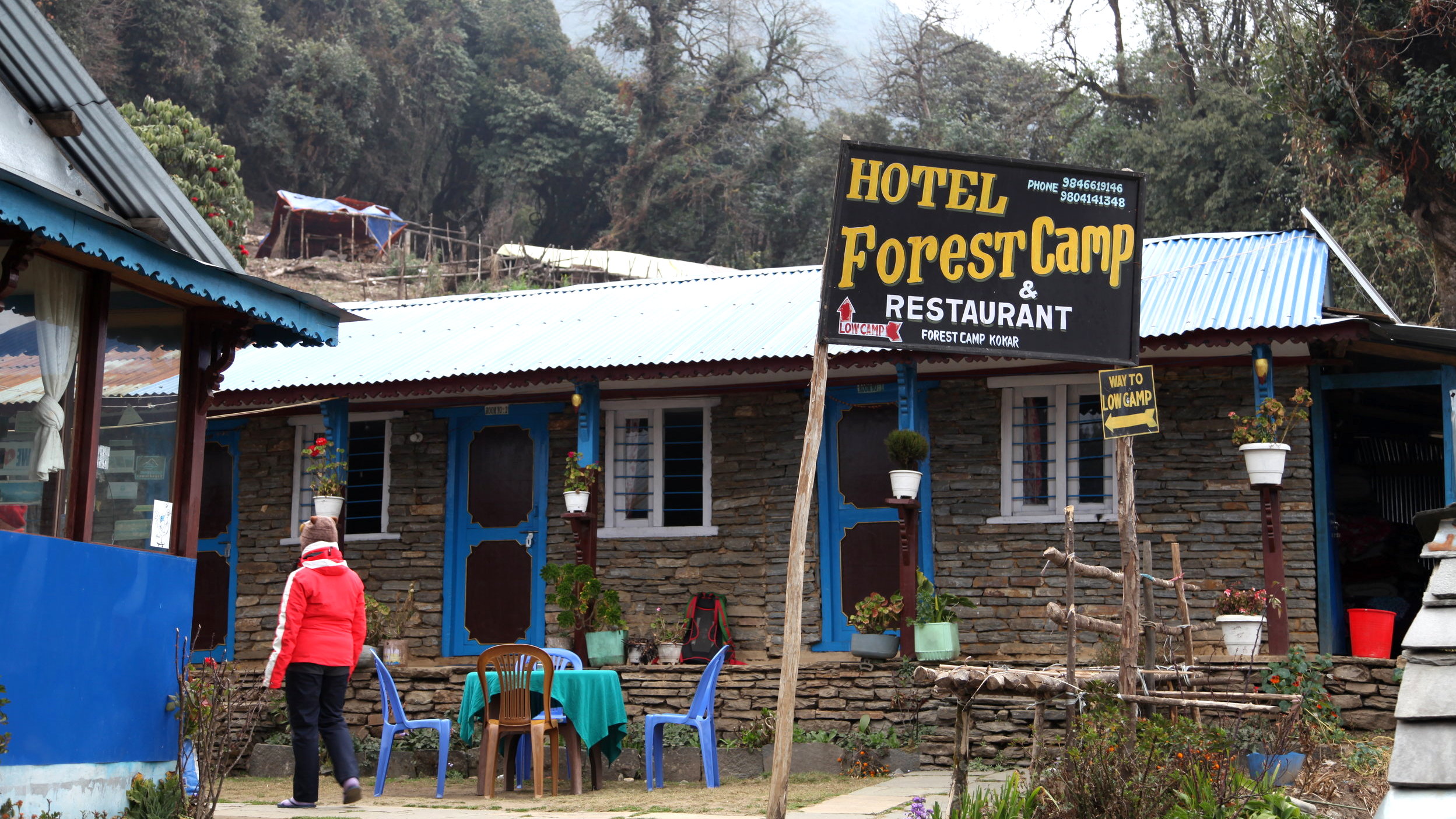
Annapurna Circuit
The Annapurna Circuit offers a similar network of teahouses and lodges along its route. The availability of accommodation can also vary depending on the season, with more options during peak trekking periods. Larger settlements like Manang and Kagbeni have more developed accommodations, including lodges with various facilities. Thorong Phedi and High Camp are popular stops for trekkers preparing for the Thorong La Pass crossing. After the pass, the descent into Muktinath provides additional accommodation options. The circuit also passes through towns and villages such as Tatopani and Ghorepani, which have lodging facilities.
Accommodations in these teahouses and lodges are basic but comfortable, providing a bed, meals, and sometimes hot showers. Keep in mind that during peak trekking seasons, especially in the Annapurna Circuit, accommodations can fill up quickly, so it's advisable to make reservations in advance or arrive at your destination early. While amenities may vary, the warm hospitality and camaraderie among trekkers create a unique and memorable aspect of the trekking experience in the Annapurna region.
What kind of food is available?
Annapurna Base Camp Trek and the Annapurna Circuit both offer a variety of food options in the teahouses and lodges along the routes. While the food choices might not be as extensive as in urban areas, the teahouses typically provide hearty and nourishing meals to sustain trekkers during their journey. Here's an overview of the types of food you can expect to find:
Common Meals
- Dal Bhat: A traditional Nepali meal consisting of steamed rice (bhat) served with lentil soup (dal), vegetables, and sometimes meat or egg. Dal Bhat is a staple and is often refilled for free.
- Momos: Dumplings filled with meat or vegetables, served with dipping sauce. Momos are a popular snack or meal option.
- Noodles and Pasta: Various noodle dishes, such as fried noodles and pasta with tomato sauce, are commonly available.
- Rice and Curry: A variety of curries, including chicken, vegetable, and paneer (cheese) curries, served with rice.
- Soups: Different types of soups, including vegetables, chicken, and mushrooms, are offered and can be especially comforting at higher altitudes.
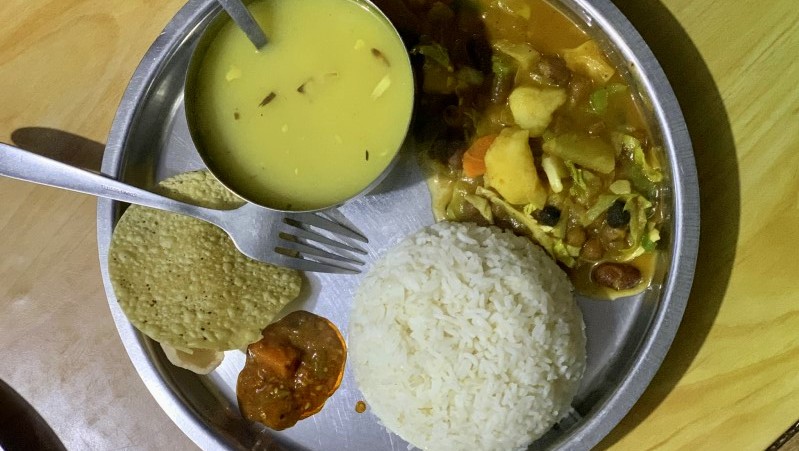
Breakfast
- Eggs: Eggs can be prepared in various ways, such as fried, scrambled, or boiled.
- Porridge: Oatmeal or local grain porridge is a warming and energizing breakfast option.
- Pancakes and French Toast: Simple pancakes or French toast with honey or jam are available at some places.
Beverages
- Tea and Coffee: Basic tea (black, milk, or masala) and coffee are widely available and provide warmth and energy.
- Hot Chocolate: Hot chocolate is a popular choice, especially in colder weather.
- Soft Drinks and Juices: Some teahouses offer soft drinks and packaged juices.

It's important to note that the availability of food items can vary depending on the altitude and the remoteness of the location. As you ascend to higher altitudes, the food options might become more limited due to transportation challenges and seasonal availability. Additionally, keep in mind that teahouses often prepare meals from locally sourced ingredients, and the menus might be adapted to suit the preferences of trekkers and the resources available in the area.
Which trek is more expensive?
The cost of trekking can vary based on several factors, including the duration of the trek, the level of comfort you prefer, the time of year, and your spending habits. In general, the Annapurna Circuit tends to be more expensive compared to the Annapurna Base Camp (ABC) Trek, primarily due to its longer duration and the additional logistics involved.
Annapurna Base Camp Trek
- Permits: The cost of permits, such as the Annapurna Conservation Area Permit (ACAP), is relatively consistent for both treks. These permits are required to enter and trek within the Annapurna Conservation Area.
- Accommodation: Accommodation options along the ABC Trek route primarily include tea houses and lodges. While accommodations are generally more basic, they are also more affordable compared to the circuit. Costs for rooms can vary, with more basic options costing less.
- Meals: Meals are available at the tea houses and lodges along the route. While prices for meals can vary, they are usually reasonable and can accommodate a range of budgets.
- Transportation: The ABC Trek starts from Nayapul or Siwai, accessible by road from Pokhara. Transportation costs to and from these starting points are relatively moderate, contributing less to the overall expenses.
- Guides and Porters: Hiring a guide or porter is optional but can enhance the trekking experience, especially for those seeking guidance and assistance. The cost of hiring a guide or porter can add to the overall expenses.
Annapurna Circuit
- Permits: Similar to the ABC Trek, the basic permit costs, including the ACAP, apply to the Annapurna Circuit. However, the circuit might require additional special permits for specific areas like Upper Mustang or Upper Dolpo, which can significantly increase the overall permit expenses.
- Accommodation: The circuit is a longer trek, requiring more nights of accommodation compared to the ABC Trek. As you progress through the circuit, accommodations can become slightly more expensive due to the remoteness of certain areas and the increased demand.
- Meals: Similar to the ABC Trek, meals are available at tea houses and lodges. However, since the circuit covers more days, the cumulative cost of meals might be higher.
- Transportation: The Annapurna Circuit involves more transportation days due to its circular route. Transportation expenses, such as buses or jeeps to various trailheads, can add up, making transportation costs a notable factor.
- Guides and Porters: Due to the circuit's longer duration and the challenge of crossing the Thorong La Pass, some trekkers opt to hire guides and porters for safety, navigation, and assistance. Hiring guides and porters comes at an additional cost.
While both treks offer budget-friendly options, the Annapurna Circuit tends to be relatively more expensive due to its longer duration, potential additional permits, accommodations in more remote areas, and transportation expenses. Trekkers should consider their preferences, priorities, and budget when deciding between the two treks.
Annapurna Circuit vs ABC Trek (Summary)
In summary, the Annapurna Circuit and the Annapurna Base Camp (ABC) Trek offer distinct trekking experiences in the Annapurna region of Nepal. The Annapurna Circuit is characterized by its longer duration of about 15 to 20 days, which leads to increased expenses due to extended accommodation and meals. The trek requires permits such as the Annapurna Conservation Area Permit (ACAP) and potentially special permits, contributing to overall costs. As the circuit includes the challenging Thorong La Pass, there are acclimatization days and additional accommodations in higher-altitude regions, impacting the budget. Additionally, certain remote areas may have slightly higher expenses due to transportation challenges and seasonal availability. On the other hand, the ABC Trek is shorter, typically taking 7 to 11 days, resulting in fewer accommodation and meal costs. It also requires permits like the ACAP. The circuit provides a broader cultural experience with diverse villages, while the ABC Trek focuses on reaching the base camp and offering spectacular views of the Annapurna Massif. Both treks have their own unique charm and financial considerations, making the choice between them dependent on personal preferences, fitness levels, and the desired duration of the trek.
Annapurna Circuit vs ABC trek-Which trek to choose?
Choosing between the Annapurna Circuit and the Annapurna Base Camp (ABC) Trek depends on your preferences, priorities, fitness level, and the type of experience you seek. Here are some factors to consider when making your decision:
Annapurna Circuit
- Duration: If you're prepared for a longer trek lasting around 15 to 20 days and want to experience a comprehensive journey around the Annapurna Massif, the circuit might be more suitable.
- Cultural Diversity: The circuit exposes you to a wide range of cultures, as you pass through various ethnic villages, each with its own traditions and architecture.
- Challenging Pass Crossing: If you're up for the challenge of crossing the Thorong La Pass and want to experience high-altitude trekking, the circuit offers a rewarding accomplishment.
- Varied Landscapes: The circuit covers diverse landscapes, from subtropical forests to alpine meadows and arid terrains, providing a rich visual experience.
Annapurna Base Camp Trek
- Shorter Duration: If you have limited time or prefer a shorter trek of about 7 to 11 days, the ABC Trek might be a better fit.
- Stunning Mountain Views: The focus of this trek is on reaching Annapurna Base Camp, providing up-close and panoramic views of the Annapurna Massif, including Annapurna I and Machapuchare.
- Less Physically Demanding: The ABC Trek involves lower altitudes and doesn't require a pass crossing, making it potentially more accessible for trekkers who are new to high-altitude trekking.
- Cultural Experience: While the cultural exposure is not as extensive as the circuit, the ABC Trek still offers insights into local life as you pass through villages and interact with residents.
Ultimately, the decision comes down to your preferences. If you're seeking a comprehensive cultural experience, don't mind a longer trek, and are up for the challenge of a high-altitude pass crossing, the Annapurna Circuit could be your choice. On the other hand, if you're focused on mountain views, prefer a shorter trek, and want to avoid extreme altitudes, the Annapurna Base Camp Trek might be more appealing. Regardless of your choice, proper preparation, acclimatization, and trekking with a qualified guide can enhance your safety and enjoyment.
Frequently Asked Questions (FAQs) about the Annapurna Base Camp Trek vs Annapurna Circuit Trek
Q. What are the most popular treks in the Annapurna region?
A. The most popular treks in the Annapurna region are the Annapurna Base Camp Trek and the Annapurna Circuit. These treks offer diverse landscapes, stunning mountain views, and insights into local cultures.
Q. How long does the Annapurna Base Camp Trek take?
A. The Annapurna Base Camp Trek typically takes around 7 to 11 days to complete, depending on your pace and acclimatization needs.
Q. Is altitude sickness a concern on the ABC Trek?
A. While the trek involves lower altitudes compared to the circuit, altitude sickness can still be a concern, especially as you approach higher points. Proper acclimatization is important.
Q. What are the highlights of the ABC Trek?
A. The main highlight of the trek is reaching Annapurna Base Camp, offering spectacular views of the Annapurna Massif, including Annapurna I and Machapuchare.
Q. How long does the Annapurna Circuit take to complete?
A. The Annapurna Circuit typically takes around 15 to 20 days to complete, covering a distance of approximately 160-230 kilometers.
Q. How challenging is the Thorong La Pass crossing?
Crossing the Thorong La Pass is physically demanding and requires proper acclimatization. Trekkers should be prepared for extreme weather conditions and high altitudes.
Q. Can I trek the circuit independently?
A. Yes, the Annapurna Circuit can be trekked independently. However, due to its challenges and remote sections, having a guide or joining a group is recommended for safety and navigation.
Q. What is the best time of year to trek in the Annapurna region?
A. The best times for trekking in the Annapurna region are during the pre-monsoon (spring) season from March to May and the post-monsoon (autumn) season from September to November. These periods offer stable weather and clear skies.
Here are some of the best trekking packages in the Annapurna Region in Nepal.
Annapurna Region Trekking Packages
Annapurna Base Camp Trek - 15 Days
Annapurna Base Camp Trek - 10 Days
Ghorepani Poon Hill Trek - 10 Days
Mardi Himal Trek - 12 Days
Annapurna in Luxury- 11 Days
Annapurna Circuit Trek - 15 Days
Annapurna Base Camp Heli Trek - 9 Days
If you need any further information, please contact us by email: at [email protected], Phone: at +977- 985 100 5129 (WhatsApp)

